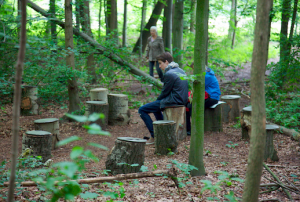For this portion of the class, we observed a portion of Kahn’s reading that involves an understanding of differentiating between different types of sound – sounds like music, noise, and phonography. Additionally, we spoke about acoustic ecology and observed many different pieces and field recordings. Kahn begins his discussion with a very interesting distinction: western art music effectively pushed away noises as sounds that music could not use. Over time, however, these “extramusical” sounds began to materialize themselves in western music in a number of ways. One of the most important ways, however, was Edison’s invention of the phonograph. Through this monumental discovery, we saw a transition into a world in which all sounds were incorporated into the world of music – as Kahn puts it, the phonograph “presented the possibility of incorporating all sound into cultural forms, shift[ing] cultural practices away from a privileging of utterance toward a greater inclusion of audition” (Kahn, 70).
Later, in the Nichols reading, we learn about the process of connecting oscillators and working with breadboards. I found this section to be very helpful in understanding how the various connections of the breadboard work, as the underpinnings of the board are simple once you fully understand how the connections work on the top. It was also very interesting to learn about oscillators (dividers, feedback loops, etc.) and the on/off features of photoresistors. Lastly, we learn about amplification and distortion and even have an example in which we amplify an electric guitar – a real world example that is interesting to learn about.
<>*<>*<>*<>*<>*<>*<>*<>*<>*<>*<>*<>*<>*<>*<>*<>*<>*<>*<>*<>*<>*<>*<>*<>
In this component of the class, we also learned about several artists that I found to be intriguing and thought provoking. Namely, I really appreciated the work of Jacob Kirkegaard through his work in Fairchild titled Transmission. In the piece, he plays various noises along all of the levels of the building, starting with deep rumblings on the first floor, all the way to chirping birds and wispy desert winds at the top. In fact, during the sound symposium, Kirkegaard spoke about the ability to always change a score from location to location, but for this piece (Transmission), you cannot recreate the piece from any other location as the noises are specific to the Arizona and Utah deserts. To that end, Kirkegaard does a nice job of demonstrating the existence of acoustic ecology and the specificness of work to a particular area – sometimes pieces do not have the flexibility that we might believe them to have.
Another interesting piece is Janet Cardiff and George Bures Miller’s Forest (For a thousand years…), in which they take over 30 speakers and place them over a calm area in the forest. The listener sits on wooden stumps at the base of the forest canopy, listening to changes that happen ever so subtly above.
To me, this piece seems to do a fantastic job of creating a sphere around the listener – an acoustic ecology that consumes our attention and fascination. While the noises range from the rustling of grass to the shooting of a machine gun, there is a unique blend that makes the forest and noises coexist. It seems as though Cardiff and Bures do an excellent job in finding this medium and making the forest both natural and yet influenced by the sound art around them.
Overall, this section of the course was excellent in progressing my knowledge of the field and I really enjoyed it. Thanks!


